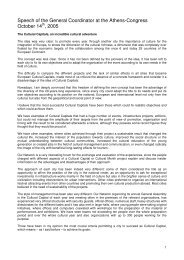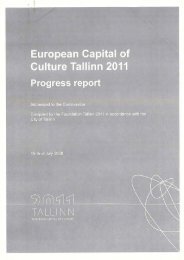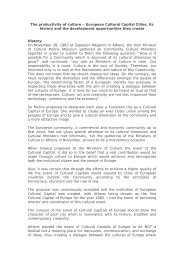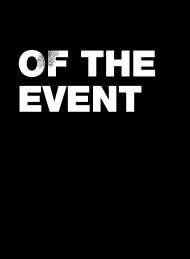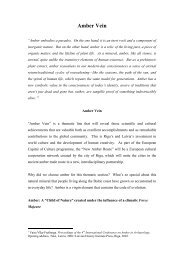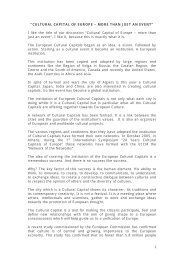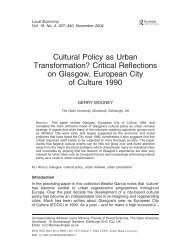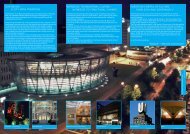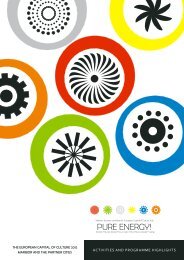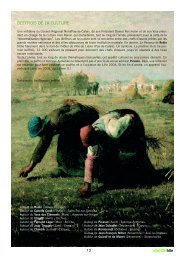Concise.pdf - Brugge Plus
Concise.pdf - Brugge Plus
Concise.pdf - Brugge Plus
- No tags were found...
Create successful ePaper yourself
Turn your PDF publications into a flip-book with our unique Google optimized e-Paper software.
The public network<br />
Introduction<br />
Nobody is obliged to participate in culture, but the culture participation policy aims to at<br />
least give people the chance to take part. Barriers that have an obstructive effect are brought<br />
down. Bruges wanted not only to enable people to participate in culture, but also – if so<br />
desired – to give them the capacity to deal with culture. Therefore a specific experiment was<br />
devised to promote participation: the public network.<br />
62<br />
BRUGGE 2002<br />
A labour-intensive grass-roots method<br />
We wanted to make the decision to come to Bruges that little bit more self-evident for<br />
everyone. Therefore contact persons were sought in the municipalities within a<br />
radius of 50 km of Bruges. Both in the provinces of West and East Flanders and in<br />
Zeeland, we found people who were prepared to commit themselves. They wanted to<br />
convey their own enthusiasm to the general public in their own area, and stimulate<br />
and mobilise these people in groups.<br />
The co-ordinator of the public network was Bram De Vos. He found, coached and<br />
supported the contact persons and kept his finger on the pulse of the network. The<br />
Minister of the Government of Flanders for Culture, at that time Bert Anciaux, gave<br />
this initiative financial backing and accorded it a place within the range of participation<br />
projects that were starting up here and there in Flanders.<br />
By the start of BRUGGE 2002 contact persons were active in all municipalities of the<br />
originally defined public network region, and some were active in various municipalities.<br />
The contact persons based themselves on their own contacts, interests and<br />
communication channels. Some used the official municipal channels, such as the<br />
municipal information sheet or the municipality’s web site. Others distributed the<br />
documentation on BRUGGE 2002 via their association or company. BRUGGE 2002 concluded<br />
a co-operation agreement with the bus company Eltebe, which carried people to<br />
Bruges at attractive prices.<br />
BRUGGE 2002 supported the contact persons’ networking activity with the necessary<br />
material (brochures, programmes, etc.), and the co-ordinator gave more than seventy<br />
information sessions. The co-ordinator also answered questions posed by the contact<br />
persons every day, by telephone or e-mail, and a general e-mail with the latest<br />
information was sent to all members of the network twice a week. When a group<br />
headed into the city, it could call on the co-ordinator to welcome it there. This mainly<br />
occurred in the House 2002 – Perez de Malvenda, where the group would be given<br />
a custom-made introduction to the event that they would be attending.<br />
© KONINKLIJK MUSEUM VOOR SCHONE KUNSTEN ANTWERPEN<br />
<strong>Brugge</strong> Inside Out<br />
© STEDELIJKE ACADEMIE VOOR SCHONE KUNSTEN - DKO<br />
Jan van Eyck, Early Netherlandish<br />
Painting and Southern Europe



